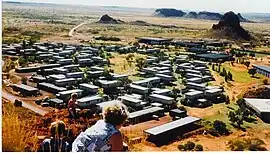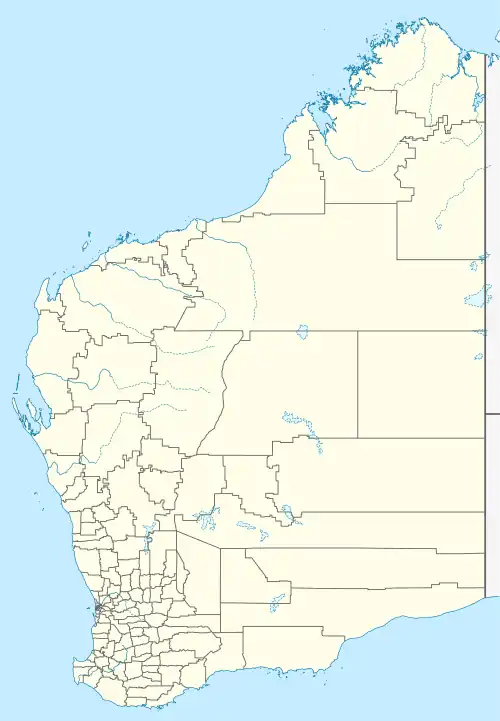Shay Gap, Western Australia
Shay Gap was an iron ore mining town in the Pilbara region of Western Australia, 1,335 kilometres (830 mi) north-northeast of Perth and 165 kilometres (103 mi) east of Port Hedland. Shay Gap was formally gazetted as a town in 1972.
| Shay Gap Western Australia | |
|---|---|
 Shay Gap in 1975 | |
 Shay Gap | |
| Coordinates | 20°29′44″S 120°09′59″E |
| Population | 0 |
| Established | 1972 |
| Abolished | 1994 |
| Elevation | 175 m (574 ft) |
| Time zone | AWST (UTC+8) |
| LGA(s) | Shire of East Pilbara |
| State electorate(s) | Pilbara |
Shay Gap was named after a pass of the same name in the hills nearby. The name of the pass has been shown on maps since 1957, and it is believed to have been named after a blackbirder, Robert Shea, part-owner of the pearler Seaspray. Shea, along with his mate Samuel Miller, was killed in November 1872 by "absconding" indentured workers while on an expedition to Mukkine (now Muccanoo Pool on Muccan Station), on the De Grey River to "recover the services of some native divers who had broken faith with him".[1][2][3][4]
Shay Gap was a company town, developed by Mount Goldsworthy Mining Associates to service nearby iron ore mines. The town was designed in 1970 by Lawrence Howroyd, for whom it won an Award of Merit in the 1974 Prince Philip Prize for Australian Design.[5] Iron ore production started in January 1973.[6][7][8]
At its peak, the town had a population of over 850 people. Mining activities ceased on 10 December 1993 and the town was closed in February 1994. Buildings and structures were either sold, demolished or relocated to Yarrie.[9][10]
References
- "Presumptive murder of two white men by natives to the eastward, and other important intelligence". The Herald. Fremantle, WA. 22 February 1873. p. 3. Retrieved 11 November 2013.
- "Western Australia". The Mercury. Hobart, Tas. 7 April 1873. Retrieved 11 November 2013.
- Allbrook, Malcolm; Jebb, Mary-Anne. Hidden Histories: Conflict, massacres and colonisation of the Pilbara (PDF). Australian Institute of Aboriginal and Torres Strait Islander Studies. Retrieved 20 November 2013.
- "Degrey River Murder". The Perth Gazette and West Australian Times. 9 May 1873. p. 3. Retrieved 5 March 2014.
- "Prince Philip Prize for Australian Design". Architectural Science Review. 17–18: 68. 1974.
- Iwanicki, Iris; Jones, David (29 April 2012), "Learning from Arid Planning and Design History and Practice: From Woomera to creating the new Roxby Downs Communities", Planning Institute of Australia 2012 National Congress 29 April – 2 May 2012 (pdf), Adelaide, South Australia: Planning Institute of Australia, retrieved 18 November 2013
- "Production of Iron". The Canberra Times. 23 December 1972. p. 14. Retrieved 18 November 2013.
- Thomas, Athol (9 June 1973). "Oasis of Comfort". The Canberra Times. p. 19. Retrieved 18 November 2013.
- Hillis, R. (1996), "BHP Iron Ore Protocol for Mine Closure", 1996 AusIMM Annual Conference, Perth (pdf), Perth, Western Australia: AusIMM
- Wahlquist, Calla (21 April 2015). "Flickers of life in West Australian mining towns even as iron ore's profits dim". The Guardian. Retrieved 8 May 2016.